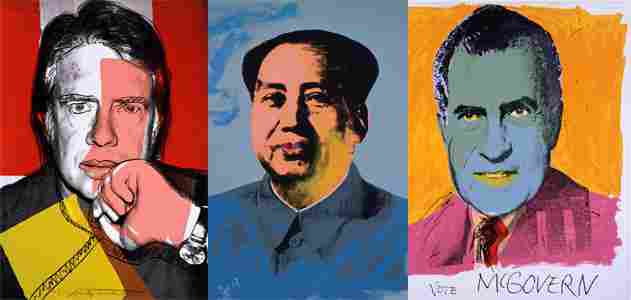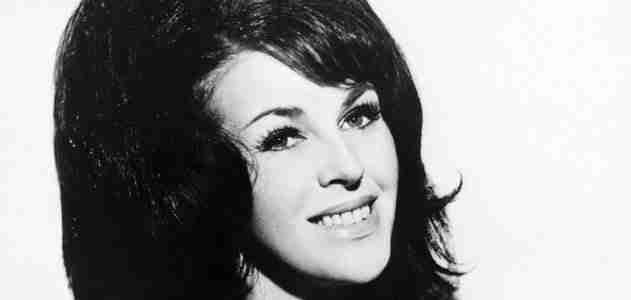Warhol’s Pop Politics

No doubt Andy Warhol, who died in 1987, would have reveled in our current media-saturated election. The artist’s own iconic images of 20th-century leaders inspired spirited debate about the pairing of politics and pop culture. So it is fitting that the first retrospective of his political works has been timed not only to coincide with this pivotal presidential election but also unveiled in New Hampshire, a state well-trod by political hopefuls and pundits. In “Andy Warhol: Pop Politics,” the Currier Museum of Art in Manchester exhibits more than 60 of Warhol’s paintings, prints, drawings and photographs, drawn largely from the collection of the Andy Warhol Museum in Pittsburgh.
A commentary on the sociopolitical climates of previous decades, the exhibition also echoes today’s increasingly mass-marketed world and its effect on the ever-thinning line between public stature and stardom. “It points to the way in which these political figures are constantly shaping their image in the public eye,” explains exhibition curator Sharon Atkins. As an example, she cites “the message sent by Jimmy Carter commissioning Warhol to do his portrait [during 1976’s presidential campaign]. It was a very directed attempt … to reach the younger voters, and the voters of New York. It was a political hopeful deliberately using Warhol’s celebrity and status to try and position himself as a progressive candidate.”
It’s a strategy not lost on those nearing the finish line in the current race to the White House. “Certainly, Barack Obama has picked up on that,” Atkins says. “There is an Obama Art Report online on which artists can post work that they are creating to raise money for his campaign. And there is the Shepard Fairey poster [of Obama] that has gotten so much attention [and] in some ways links right back to Warhol and some of the work he was doing.”
Warhol, born Andrew Warhola in 1928, studied graphic arts at the Carnegie Institute of Technology in his native Pittsburgh before working as a commercial artist and illustrator in New York City. He became a symbol of the counterculture movement in the early 1960s for his bold Pop Art works, which drew both praise and criticism for their similarity to commercial advertisements. By emphasizing techniques used by professional printers, and later employing studio assistants to help craft his works, he forced the question of what constituted art and transformed portraiture into a representation of an era. An eclectic artist, he remains best known for his renderings of American cultural staples, from Campbell’s Soup cans to Hollywood starlets and the political elite.
Warhol was captivated by the blurring boundaries between political stumping grounds and star-studded circles, where reinvention is an art and “politicians and actors can change their personalities like chameleons,” he once said. As a result, Warhol infused a sense of celebrity into his portraits, using jolting hues and exaggerated graphic elements while deliberately glamorizing facial features. “Warhol so idealizes his sitters,” Atkins says. “Pat Hackett [editor of the The Andy Warhol Diaries ] mentions him working like a plastic surgeon, tightening skins, straightening noses, smoothing out wrinkles.”
Another distinctive characteristic was his use of repeated images to suggest that the road to stardom is lined with relentless public relations campaigns. Warhol’s series on Chinese dictator Mao Zedong was a response to the Communist Party propaganda machine, which plastered China with a half-smiling image of the leader that was then replayed throughout the United States in news coverage of President Richard Nixon’s groundbreaking 1972 visit to that nation. Warhol’s series renders that ubiquitous image of Mao, but with facial features, clothing and backdrops in varying shades.
Warhol’s official position was political neutrality, but his party leanings are evident in one piece that resulted after the Democrats asked him for a contribution to George McGovern’s Presidential race against Nixon, the Republican incumbent. Titled Vote McGovern, 1972 , the piece appears to be a visual invitation to contemplate the true colors of politics. It depicts Nixon with blazing yellow-rimmed eyes, lime-tinted lips suggesting foaming at the mouth, and a ghoulish green-blue facial cast. Warhol’s hand-written words beneath Nixon’s face read: “Vote McGovern.”


Warhol’s artwork represents a multilayered process that incorporated photographs, screen prints, paintings and graphics. Though he used scores of Polaroid images for later commissioned portraits, Warhol initially relied on “source images,” such as newspaper clippings, for many figure studies. One example is the centerpiece of the exhibition, Flash-November 22, 1963 , which Warhol created in 1968 using Teletype reports to chronicle the fervor surrounding John F. Kennedy’s assassination and funeral. In one of the portfolio’s 11 works, a director’s clapboard is superimposed over Kennedy’s face, the scene marker serving as a metaphor for the endless takes played out in the persistent airing of the Abraham Zapruder film footage of the tragic event. “The repetition that Warhol responded to is very much connected to the sort of “YouTube” world that we live in now, where you can replay anything and everything over and over again,” Atkins says.
Flash was purchased in 2005 as New Hampshire’s Currier Museum headed into a $21 million expansion project, and while the intent initially was to bolster the gallery’s Pop Art collection, the acquisition soon became the focal point of what would be the gallery’s first major exhibition after reopening this year. “I was very surprised to see that the political portraits had never been looked at as a whole,” says Atkins, adding that when Currier officials realized the exhibition would coincide with the 2008 presidential election, “it was the perfect fit.”
“Andy Warhol: Pop Politics” can be viewed at the Currier Museum of Art in Manchester through January 4, 2009. Gallery hours are 11 a to 5 on Sundays, Mondays, Wednesdays, Thursdays and Fridays and 10 a to 5 on Saturdays, with free admission offered from 10 a to noon. In addition, the museum offers extended hours the first Thursday of each month from 11 a to 8 For more information, call (603) 669-6144 or go to urrierrg.
The show moves to the Neuberger Museum of Art at Purchase College, the State University of New York, from February 15 through April 26, 2009.
Julia Ann Weekes is editor of the weekend arts section of the New Hampshire Union Leader in Manchester, New Hampshire.
Free for All

It doesn’t matter why we receive it—free stuff makes us happy. But sometimes, most of the time actually, it turns out to be junk. Or really not free at all.
But my belief in free-is-crap has been shaken. In January, the cultural ministry of France announced that entrance to all its national museums would be free for the next six months. In a place where the prime minister has attested that the country is in a state of bankruptcy, this is quite the grand gesture.
And what a boon. There are 18 amazing national museums in France including the Louvre, the Centre Pompidou and Quai Branly. Now no one will waste precious art-gawking time steeped in bitterness because they had to pay just for the mere opportunity to look.
The motive for such beneficence is to draw young people and locals into the museums. There are strings attached. Some of the museums are free all the time, others only one day a week. Still others are putting an age limit—26—on the free ride.
Half way through the experiment, which will be revisited by the French government in June, some have criticized the plan saying that only tourists benefit. However, since England dissolved their museum admission fees five years ago, almost 30 million additional visits have been made to that country's museums. If France wants to see similar increases, then keeping its national institutions fee-free may be the lure citizens need to get off the couch and into the museum.
On the Job: Broadway Producer

Jeffrey Seller has an eye and ear for what works on Broadway. Dubbed a "power hitter" on the Great White Way, the two-time Tony Award winner has produced Rent , Avenue Q , De La Guarda , La Bohème and High Fidelity . Smithsonianom goes behind the scenes with Seller as he prepares for the end of Rent 's 12-year run and the beginning of In the Heights , an energetic new musical about life in New York City's Washington Heights.
How did you get into this line of work?
When I graduated from [the University of] Michigan, I moved to New York. I found my first job doing publicity at a four-man pr operation that did a little bit of theater, a little bit of television. Less then a year later, I got a job in the famous Broadway producers Barry and Fran Weisler's office. They deposited me in their booking division, so at age 22 I was an assistant booker, booking national tours of Broadway shows. Though it was the least fun job in the office and the most removed from the action of putting a new show on Broadway, what that job taught me was the road. And the road is about 60 percent of the actual full Broadway business. I learned virtually everything there is to know about touring Broadway musicals. I knew every theater in America. I knew how to negotiate the deals. I knew how they picked their seasons. While I was booking shows by day, I was still producing theater by night. I was producing shows at little theater spaces all over Manhattan, and I was doing them with my friends, one of whom became Jonathan Larson [writer of Rent ]. It was at that time in my life—when I'm about 25 years old—that I saw his one man show called Boho Days and wrote him a letter saying I want to produce your musicals. When Rent opened on Broadway, I was 31 years old.
What kind of background or skill set does it require?
My work requires an extraordinary passion for the theater, an extraordinary knowledge of the theater and musical theater and knowledge of the history of musical theater, particularly from the 1940s to the present, or Oklahoma to the present. Along with those qualities, I combine my salesmanship. When I walked into a local merchant's business at 13 years old and said, "Would you please put an ad in my program, and I'll put your business card in the program and you give me $20?" I was learning how to raise money. I was learning how to sell. Every great producer is also a great salesman.
What's an average day like?
In an average day I'm spending some time talking with my marketing director about advertising, planning the advertising strategies of my shows for the next quarter, making strategic decisions about spending money on radio versus spending money on television, making strategic decisions about what the content should be of a commercial for In the Heights . What should that commercial do? What should it look like? How should it feel? What should the poster of In the Heights look like? How do we arrive at those decisions? That's part of how I spend my day. I have some sort of phone meeting or live meeting with my director [of In the Heights ] every day. I speak with the book writer everyday. I speak with the artists and composer every day. I'm speaking with the agents for the artists on a regular basis. I'm also planning my next two shows. I'm on the phone working on, what are we doing next year? Once a show is open and running on Broadway, I turn that show over to my team–my managers, marketing directors and publicists–because then my job is what are we doing next? That's how I ensure there is a next.
What's the most interesting part of your job?
The most interesting part of my job for me is nurturing the creators of the musicals, offering support, criticism, insight and hoping that I might influence them in a positive way that might result in a better work.
What has been your most exciting moment on the job?
There will never be a moment more exciting than bringing Rent to Broadway. There will never be a moment sadder than the death of Jonathan Larson, the creator of Rent , on the day of the first preview off Broadway. And there will probably never be a moment more fun than winning the Tony for Avenue Q , when it was considered the upset of the century.
Any downsides?
I'm a very lucky man. My avocation is my vocation. What I did for fun as a child, I do for a living as an adult.
As a producer, what do you look for in a show?
It's visceral, purely visceral. I feel it or I don't. But what do I look for? I want to be surprised. I want to have an experience I've never had before, which was certainly the case with Rent , Avenue Q and my newest production In the Heights . When I attended the first reading of In the Heights and the show started with the opening number, I had never heard a Broadway musical sound like that. I was instantly hooked. We hope that the young artists toiling away at writing new musicals have the ingenuity to find a way to get guys like me into the room. And usually the right ones do.
What did you see in Rent when you first saw it?
I felt like I loved those characters. I knew those characters. Rent seemed to be speaking to everything I was feeling about the world. I don't want to be a booker, I was thinking. I want to be a producer. Rent 's got that issue all tied up in it. How do I pursue my dreams without selling out? How do I create an alternative family? Rent spoke to me so directly, to feelings and values that I had as a young person in my late 20s, early 30s.
Do you have any idea how many times you've seen the show?
God no. Probably more than 50. More than most, but not as many as some. I'm sure there are Rent heads who have seen the show more than me.
How do you feel about the closing of the show on June 1?
I thought, wow, Rent has defined so much of my adult life. It has defined my career. It cracked open my career. I kind of divide my life into pre- Rent and post- Rent . Closing is sad because we come to expect of a show that it will always be there, and then when we realize it is time to close, we're reminded of the cold reality of life, which is that everything comes to an end. But I'll get over it. The great thing about musicals is that they live on after we do them on Broadway in a way that is unique. Remember, most people who experience musicals, like I did as a kid, don't experience them on Broadway. They experience them when they do them in their Purim plays, when they do them in school, when they see them in community theater. And that's what happens to Rent next. So Rent moves on to the next stage of its life, and that will make me very happy.
What is Broadway losing?
It's losing those beloved characters. It's losing that groundbreaking, emotional, brilliant score. But Broadway moves on. Groundbreaking, fresh, surprising musicals are continuing to bang down the doors of Broadway.
What is Broadway gaining with In the Heights ?
Broadway is gaining a whole new sound that people have never heard before. Broadway is gaining an extraordinary new artist named Lin-Manuel Miranda, who conceived the show, wrote the music and the lyrics. It's gaining a fabulous new playwright named Quiara Alegría Hudes, who was a Pulitzer Prize finalist last year and penned the book to this. Broadway is gaining a whole new generation of artists and performers that it didn't have before and who are mesmerizing the audience every night with their story of life in Washington Heights. It's appealing to grandmothers and little kids and everyone in between as well.
What advice would you give to someone interested in becoming a producer?
Forge relationships with the composers, lyricists, book writers and directors that you believe in. As a developing producer, you will rise or fall with the developing artists who you choose to nurture. Harold Prince teamed up with [Richard] Adler and [Jerry] Ross, [John] Kander and [Fred] Ebb, and most significantly, [Stephen] Sondheim. These were all his peers. Cameron Mackintosh teamed up with Andrew Lloyd Webber. Your job is to discover the next great generation of artists.




Post a Comment